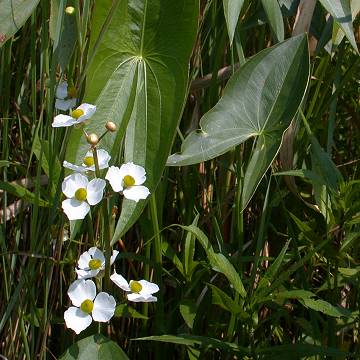

Sagittaria latifolia - (image 1 of 7)
Taxonomy
Family: Alismaceae
Habitat
Marshy borders of ponds and streams. Bogs. Can produce almost solid stands in artificial waterways, like canals. Tolerant of pollution.
Associates
Acnida altissima, Alisma subcordatum, Asclepias incarnata, Iris virginica, Leersia oryzoides, Rumux verticillatus, Scirpus fluviatilis, Scirpus validus creber, Sium suave, Sparganium eurycarpum, Typha latifolia. In bogs with Calamagrostis canadensis, Thelypteris palustris, Dulichium arundinaceum, Polygonum coccineum, Pontederia cordata, Potentilla palustris.
Distribution
Nova Scotia and Quebec to AK, south to NY, northern Ontario, IL, OK, TX and CA.
Morphology
Herbaceous perennial. Plants monoecious; occasionally dioecious. Emersed leaves nearly all sagittate to sagittate-hastate at the base. pistillate heads mostly pedicellate; filaments smooth, without scales; bracts obtuse to acute, rarely subacuminate, up to 1 cm long; stamens mostly more than 25. Beak of achene usually over 1 mm long, bent at a right angle, oriented horizontally to the long axis of the achene; face of the achene plane.
Notes
Flowers mid June to early September
Wetland indicator: Obligate
These plants appear to be dioecious. The first 3 images are of pistillate heads, the last 3 show staminate heads.
References
Gleason, Henry A. and A. Cronquist. 1991. Manual of Vascular Plants of Northeastern United States and Adjacent Canada. Second Ed.
The New York Botanical Garden. Bronx, NY
Swink, F. and G. Wilhelm. 1994. Plants of the Chicago Region.
Indiana Academy of Science. The Morton Arboretum. Lisle, Illinois.
|
Michael Hough © 2005 |